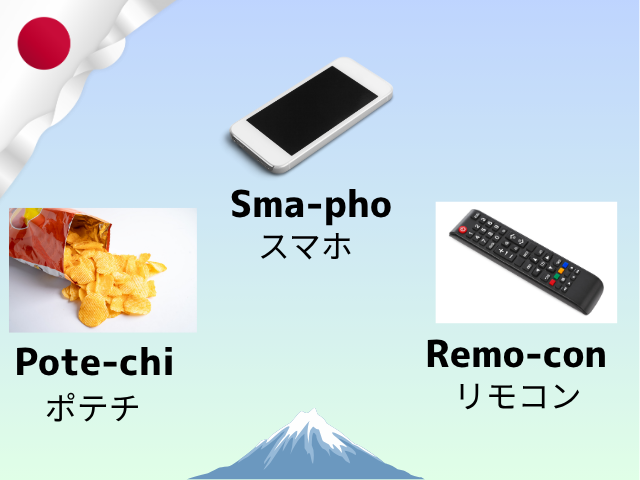From remote control becoming Remo-con to smartphone becoming Sma-pho,
abbreviations are a fun and natural part of everyday Japanese communication.
1. Why Japanese People Shorten Words

Japanese culture values efficiency and simplicity, but there’s more to it than that.
The Japanese language has a natural rhythm made of short syllables,
so shortening words makes them easier to say and gives them a catchy, rhythmic sound.
That’s why even foreign brand names and people’s names get shortened based on sound, not spelling:
- Starbucks → Staba
- Banana Republic → Bana-ripa
- Brad Pitt → Bra-pi
Foreigners visiting Japan are often surprised — and amused — to hear these local versions of familiar names.
2. How Abbreviations Are Formed

Most Japanese abbreviations take the first few syllables of each word and combine them.
This keeps the rhythm short, light, and easy to pronounce.
- Remote Control → Remo-con
- Smart Phone → Sma-pho
- Potato Chips → Pote-chi
- Dreams Come True → Dri-cam (a pop music duo)
To native English speakers, these may sound strange or random,
but for Japanese speakers, they feel perfectly natural and even friendly.
3. Everyday Abbreviations You’ll Hear in Japan

Here are some everyday Japanese abbreviations that people use without even thinking —
many of them might surprise you!
- Akogi – Acoustic guitar
- Apo – From “appointment,” but in Japanese it almost always means
“setting up a meeting” or “making an arrangement to see someone,” especially in business. - Amefuto – American football
- Eakon – Air conditioner
- Dejikame – Digital camera
- Frima – Flea market (also for resale apps like Mercari)
- Metabo – Metabolic syndrome (health slang)
- Resutora – Corporate restructuring or layoffs
- Reiya – Cosplayer (“cosplay player” shortened)
- Kontakuto – Contact lenses
- Arumi – Aluminum (especially foil)
- Anpai – “Safe choice,” originally from Mahjong slang meaning “safe tile”
To Japanese people, these sound completely normal —
but to non-Japanese speakers, they can feel like secret code words!
4. A Long Tradition of Wordplay
This creative use of language isn’t new.
Since the 1960s, youth culture in Japan has used abbreviations as a way to sound fresh and modern.
Words like Sab-cal (subculture) or An-gra (underground)
reflect how language evolves alongside music, fashion, and art.
5. Abbreviations as a Reflection of Japanese Creativity

Abbreviations show how adaptable the Japanese language is.
They make words shorter, more rhythmic, and more “Japanese” in sound —
a perfect reflection of the country’s balance between practicality and playfulness.
So next time you hear someone say, “Let’s go to Staba after work,”
just smile — they’re not speaking in code. That’s Starbucks, Japanese-style.

